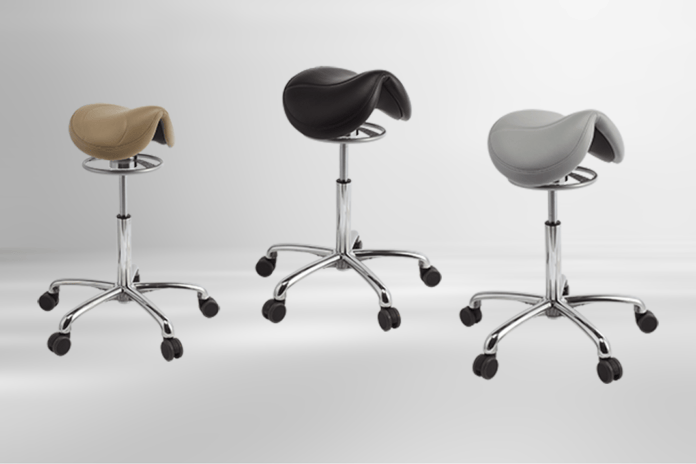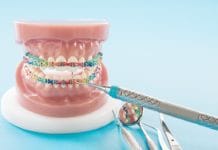Disclosure: This article is sponsored content from The Brewer Company as part of our sponsored partner program.
The prevalence of back pain in dentistry over the past 50 years is at a steadfast 67%.1 According to Dr. Bethany Valachi, a physical therapist, one in two dental professionals experienced back pain during a 12-month study.2
At some point when standing dentistry transitioned to seated dentistry, it was thought that sitting with thighs at a 90-degree angle was a good idea. However, work-related physical complaints are increasing. This often-practiced seating position is wrecking dental professionals’ musculoskeletal system and accounting for increased chronic pain resulting in early retirement and missed worked days.
According to the American Dental Association, over 300,000 work-related injuries can be prevented with the use of ergonomic intervention. Dental professionals are more at risk of developing musculoskeletal disorders (MSD) than any other health professional.3 This is related to the fact that we spend hours in static positions, often leaning forwards. With just a simple adjustment, dental professionals can improve their quality of health and help increase career longevity.
For years, dental professionals have been practicing what they were taught in school – to sit at a right angle with thighs parallel to the floor. This does not seem that big of a monstrosity to most, except once the evidence is placed on the table it is easy to see that sitting at the same angle of a box is actually a terrible concept.
Dr. Valachi suggests the following demonstration to illustrate the correct placement of the spine. Place yourself in a flat seat and place your hand on the lower back, feeling the position of the lumbar spine. Without moving your hand, scoot to the edge of your chair so that your thighs slope downward. Your spine should shift from a flat to a naturally curved position.4 This is the position dental professionals should strive to achieve while practicing dentistry.
What’s Wrong with a Horizontal Chair?
Many of you are already conjuring ways to adapt your flat seat chair to accommodate the neutral seated position. Before you go much further, let’s dissect the horizontal chair. Because of the nature of practicing dentistry, professionals tend to naturally lean forward. This placement, combined with sitting in a flat seat, is detrimental to the spinal musculature and discs, which can lead to premature disc degeneration.
Flat seating effects more than the spine. Improper posture can promote heartburn, incontinence, and constipation.5
Research suggests that hips be placed higher than the knees and a chair with a downward tilt to open the hip angle and decrease disc pressure, reduce low back pain, and allow the clinician to sit closer to the patient.4 However, when activating the tilting mechanism on a horizontal chair, it is challenging to determine if the angulation is enough or possibly too much. Tilting a horizontal chair often presents the challenge of sliding forward when seated. Horizontal seating also places posterior pressure on the thighs, which decreases blood flow to the lower extremities. Dental professionals can spend up to 60,000 work hours in uncomfortable positions over the course of their career that lead to musculoskeletal disorders.6
Why a Saddle Stool?
Over 30 years ago, an occupational therapist and avid horseback rider was asked by a severely injured patient of hers to be taken horseback riding. The success of this endeavor was so prominent that the doctor in charge began sending other patients horseback riding. The therapist questioned how an injured person could sit unaided on a horse but not in an ordinary seat. It occurred to the therapist that the horse saddle allowed the spine to assume its natural curve, and thus the saddle stool was born.
Allowing the spine to assume the natural “S” position allows for easier breathing, head and neck pain to recede, increase in stamina and dexterity, improved circulation, and lowers the risk of hip pain. When the body is placed in a neutral position while seated, the body is symmetrical, balanced, and comfortable, thus decreasing stress on the musculoskeletal system. A neutral position as defined by the Journal of Medicine and Life requires the angle of the thighs to shanks be at 105 degrees or more, that thighs be 45 degrees apart, and the feet facing forward while symmetrically balanced under the operator’s hands.7
Saddle stools are designed to place clinicians in an ergonomically correct position to increase comfort and decrease injury. With several variations of saddle stools flooding the market, it is important to select the one that is appropriate for you. Bear in mind that what works for one may not work for you.
- Contour: Selecting a saddle stool that is the right contour for your pelvis is important to prevent further discomfort. A stool that is too narrow can cause compression, and one that is too wide can cause an uncomfortable splay of the hips.
- Dynamic motion: The Brewer Company has a stool that offers a 360° dynamic motion in efforts to strengthen the core muscles. A stronger core has proven to reduce MSD and increase endurance. The 360-degree dynamic motion is similar to the concept of balancing on a Pilates ball. This freedom of movement can be incorporated gradually until the clinician is comfortable with the full range of movement.
- Cylinder height: It should also be noted that choosing a stool that accommodates your height is equally important in order to customize the seating to your stature.
- Custom-fit: While it may be tempting to purchase a saddle stool from an e-commerce site for a bargain price, it should be mentioned that saddle stools need to be individually selected to achieve the best results. Speaking with representatives from saddle stool companies will help you purchase a stool tailored to your needs.
Saddle stools are increasingly growing in popularity. In a perfect world, all dental offices would be equipped with this type of seating, with the fit individualized to each clinician. However, until it is collectively and widely recognized, dental professionals should choose to make the switch individually based on their needs. Whether you are seasoned or just beginning your dental professional career, making this small ergonomically tailored altercation can add years to your career.
References
- Valachi, B. 5 Steps to Practicing Pain-Free Dentistry. Posturedontics. 2017.
- Valachi, B. Low Back Pain and Dental Stools. Posturedontics, Retrieved from https://posturedontics.vipmembervault.com/user/units/view/22/?lesson=102.
- Brignardello-Petersen, R. Saddle seats seem to reduce the ergonomic risk score compared with conventional seats among dental students. The Journal of the American Dental Association. 2019; 150(6): e100. Retrieved from https://jada.ada.org/article/S0002-8177(19)30098-4/abstract.
- Valachi, B. Operator Seating the Tall and Short of It. Dentistry Today. January 1, 2005. Retrieved from https://www.dentistrytoday.com/ergonomics/1116–sp-858836667.
- 3 Surprising Risks of Poor Posture. Harvard Health. Sept. 2018. Retrieved from www.health.harvard.edu/staying-healthy/3-surprising-risks-of-poor-posture.
- Practice Successfully, Live Well: Ergonomic Advice to Reduce Work-Related Pain. American Dental Association: New Dentist Blog. Dec 2017. Retrieved from https://newdentistblog.ada.org/practice-successfully-live-well-ergonomic-advice-to-reduce-work-related-pain/.
- Pîrvu, C., et al. The Dentist’s Operating Posture – Ergonomic Aspects. Journal of Medicine and Life. 2014; 7(2): 177-182. Retrieved from www.ncbi.nlm.nih.gov/pmc/articles/PMC4151237/.













